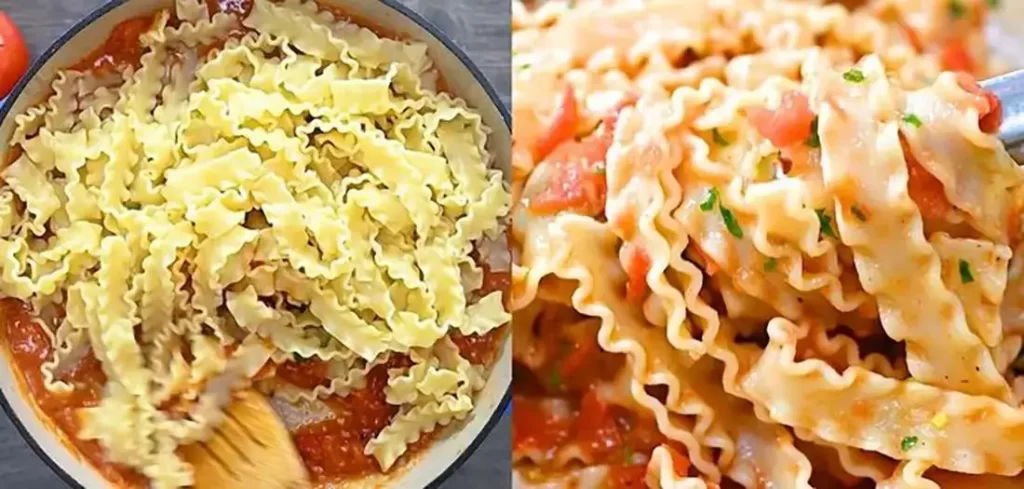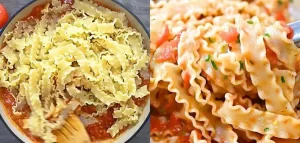Table of Contents
Mafaldine pasta, with its beautiful, ruffled edges and delightful chew, is a delicious canvas for many sauces. In this recipe, we’re pairing it with a creamy, slightly tangy sauce made from goat cheese, enhanced by the bright flavors of pesto and the earthiness of fresh spinach. Whether you’re new to cooking pasta or looking to perfect your technique, this dish brings out the best in each ingredient.
How to Make Mafaldine Pasta with Spinach and Goat Cheese

Ingredients for a Flavorful Mafaldine Pasta Dish
Let’s start by gathering everything you need to make this dish a success:
Core Ingredients:
- Mafaldine pasta: 12 oz (340g) – This pasta shape, with wavy edges, is ideal for trapping creamy sauces. If you don’t have mafaldine, pappardelle or tagliatelle are suitable substitutes.
- Butter: 3 tablespoons – Butter adds richness and helps to build the base of the sauce.
- Spinach: 2 cups, chopped – Fresh spinach works best, though frozen spinach can also be used if drained and thawed properly.
- Garlic: 2 cloves, minced – Fresh garlic brings a robust, aromatic note that complements the goat cheese.
- Goat cheese: 4 oz, softened – Goat cheese provides creaminess with a hint of tang. Choose a mild variety if you prefer a softer flavor.
- Parmesan cheese: ½ cup, grated – Parmesan adds an umami punch that balances out the sauce.
- Pesto: 2 tablespoons – Pesto enriches the sauce with basil and pine nut flavors. Store-bought pesto works well, but fresh homemade pesto can be even more flavorful.
- Heavy cream: ½ cup (or adjust for desired consistency) – Cream helps create a smooth, rich sauce.
- Pine nuts: 2 tablespoons, toasted (optional, for garnish) – Pine nuts add a delicate crunch and nutty flavor.
- Salt and pepper: To taste
- Fresh basil: A handful, chopped (optional garnish) – Fresh herbs elevate the presentation and add an aromatic touch.
- Lemon zest: Zest of 1 lemon (optional for freshness) – Lemon zest lightens the dish and pairs beautifully with goat cheese.

Step-by-Step Instructions
1. Cook the Mafaldine Pasta
- Begin by boiling a large pot of salted water. Add the mafaldine pasta and cook until al dente, which usually takes about 10-12 minutes. Be sure to taste a strand to ensure it’s firm but tender.
- Just before draining, reserve about a cup of pasta water. This starchy water can be added later to help the sauce adhere to the pasta and give it a silky texture. Drain the pasta and set it aside.
2. Make the Creamy Goat Cheese and Spinach Sauce
- Heat a large skillet over medium heat. Melt the butter, then add the minced garlic. Sauté for about a minute until the garlic becomes fragrant and golden, releasing its full lavour.
- Add the chopped spinach to the skillet. Sauté it for about 2 minutes or until it wilts, stirring occasionally. If using frozen spinach, drain it well to avoid excess water.
- Reduce the heat to low and add the softened goat cheese, parmesan cheese, pesto, and heavy cream. Stir everything together, allowing the goat cheese and parmesan to melt and create a smooth, creamy consistency. This step is where you can adjust the sauce’s thickness by adding a small amount of the reserved pasta water as needed.
3. Combine Pasta and Sauce
- Add the cooked mafaldine to the skillet, gently tossing to coat the pasta in the sauce. Take your time here, ensuring every ribbon is covered. Adjust the sauce’s consistency as needed by adding more pasta water, a little at a time, until it’s just right for your preference.
- Season the dish with salt and freshly ground black pepper to taste, and add the lemon zest if desired. The zest will brighten the dish and balance out the richness of the sauce.
4. Serve and Garnish
- Transfer the pasta to serving plates. Garnish with toasted pine nuts for added crunch, a sprinkle of fresh basil for a pop of color, and a touch more parmesan if desired. Serve hot to enjoy the flavors at their best.

Tips for Perfecting Your Mafaldine Pasta
- Balancing the Sauce: Goat cheese can be tangy, so adjust the amount based on your taste preference. A little extra cream or parmesan can help mellow it if needed.
- Adding Freshness: A hint of lemon zest or fresh basil brightens the flavors, especially if the sauce feels too rich.
- Toast Your Pine Nuts: Lightly toasting the pine nuts in a dry pan before garnishing adds a nutty depth and crunchy texture to the dish.
- Experiment with Pesto: Homemade pesto can add a fresh, vibrant taste, but store-bought works too. Try sun-dried tomato pesto for a unique twist.
What to Serve with Mafaldine Pasta
Appetizers:
- Antipasto Plate: An array of olives, artichokes, cured meats, and Italian cheeses like burrata or mozzarella complements the pasta’s creamy texture.
- Tomato Bruschetta: Fresh tomato, basil, and a touch of balsamic vinegar on toasted baguette slices offer a lighter, refreshing start.
Proteins:
- Grilled Chicken: Lean and flavorful, grilled chicken pairs nicely with the creamy goat cheese sauce without overpowering it.
- Sautéed Shrimp: Shrimp adds a delicate, slightly sweet taste that complements the pesto and goat cheese.
- Pan-Seared Salmon: For a richer protein option, try salmon, which holds up well against the bold flavors in this dish.
Beverages/Drinks:
- White Wine: A light and crisp Sauvignon Blanc or Pinot Grigio enhances the creamy and tangy notes in the pasta.
- Sparkling Water with Lemon: For a non-alcoholic option, lemon or cucumber-infused sparkling water refreshes the palate.
Desserts:
- Lemon Sorbet: This light dessert cleanses the palate after a creamy main course.
- Tiramisu: A classic Italian choice, tiramisu’s creamy, coffee flavors pair well with the pasta’s rich notes.
Delicious Variations to Try
- Vegetarian Mafaldine Primavera: Add a mix of vegetables like bell peppers, zucchini, and cherry tomatoes to make it a hearty vegetarian main.
- Spicy Mafaldine Arrabbiata: For heat lovers, use a tomato-based sauce with red chili flakes in place of the creamy pesto sauce.
- Mafaldine Bolognese: Swap the goat cheese sauce with a meat sauce or traditional Bolognese for a heartier version.
FAQs about Mafaldine Pasta
What makes mafaldine pasta unique?
Mafaldine’s ruffled, ribbon-like edges hold sauces exceptionally well, adding a texture that enhances both creamy and chunky sauces. It’s named after Princess Mafalda of Savoy, lending a touch of elegance to the dish.
What is mafaldine pasta? Mafaldine (or mafalda) pasta has flat, ribbon-like noodles with wavy edges, named after Princess Mafalda of Savoy. Its unique shape holds sauces beautifully, making it perfect for creamy or chunky sauces.
Can I substitute goat cheese with other cheeses?
Yes, for a milder flavor, you can replace goat cheese with ricotta or mascarpone, which will still create a creamy texture but with a less tangy profile.
Is there a gluten-free alternative to mafaldine pasta?
Certainly! Many gluten-free options mimic the texture of mafaldine, such as gluten-free pappardelle or other ribbon-like pastas available at specialty stores.
How can I make it lighter?
For a lighter version, replace heavy cream with a splash of milk or vegetable broth and use low-fat cheeses. A generous amount of fresh basil or parsley can add flavor without extra calories.
Nutrition Information (Per Serving)
- Calories: ~460 kcal
- Protein: 15g
- Carbohydrates: 62g
- Fat: 16g
- Calcium: 130mg
- Iron: 3.5mg
With these insights and tips, you’re set to make a spectacular mafaldine pasta that’s sure to impress. Enjoy this creamy, flavor-packed dish that’s perfect for a cozy dinner, and feel free to experiment with your own touches!




 Let’s start by gathering everything you need to make this dish a success: Core Ingredients:
Let’s start by gathering everything you need to make this dish a success: Core Ingredients: